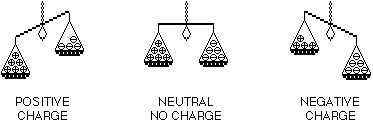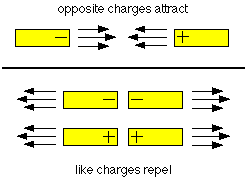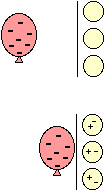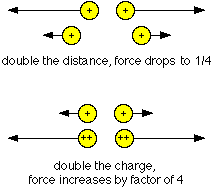
You walk across the rug, reach for the doorknob and..........ZAP!!! You get a shock.

To understand what static electricity is, we have to learn a little bit about the nature of matter. Or in other words, what is all the stuff around us made of?
Imagine a pure gold ring. Divide it in half and give one of the halves away. Keep dividing and dividing and dividing. Soon you will have a piece so small you will not be able to see it without a microscope. It may be very, very small, but it is still a piece of gold. If you could keep dividing it into smaller and smaller pieces, you would finally get to the smallest piece of gold possible. It is called an atom. If you divided it into smaller pieces, it would no longer be gold.

Everything around us is made of atoms. Scientists so far have found only 115 different kinds of atoms. Everything you see is made of different combinations of these atoms.
So what are atoms made of? In the middle of each atom is a "nucleus." The nucleus contains two kinds of tiny particles, called protons and neutrons. Orbiting around the nucleus are even smaller particles called electrons. The 115 kinds of atoms are different from each other because they have different numbers of protons, neutrons and electrons.

It is useful to think of a model of the atom as similar to the solar system. The nucleus is in the center of the atom, like the sun in the center of the solar system. The electrons orbit around the nucleus like the planets around the sun. Just like in the solar system, the nucleus is large compared to the electrons. The atom is mostly empty space. And the electrons are very far away from the nucleus. While this model is not completely accurate, we can use it to help us understand static electricity.
(Note: A more accurate model would show the electrons moving in 3- dimensional volumes with different shapes, called orbitals. This may be discussed in a future issue.)
Protons, neutrons and electrons are very different from each other. They have their own properties, or characteristics. One of these properties is called an electrical charge. Protons have what we call a "positive" (+) charge. Electrons have a "negative" (-) charge. Neutrons have no charge, they are neutral. The charge of one proton is equal in strength to the charge of one electron. When the number of protons in an atom equals the number of electrons, the atom itself has no overall charge, it is neutral.
The protons and neutrons in the nucleus are held together very tightly. Normally the nucleus does not change. But some of the outer electrons are held very loosely. They can move from one atom to another. An atom that looses electrons has more positive charges (protons) than negative charges (electrons). It is positively charged. An atom that gains electrons has more negative than positive particles. It has a negative charge. A charged atom is called an "ion."

Some materials hold their electrons very tightly. Electrons do not move through them very well. These things are called insulators. Plastic, cloth, glass and dry air are good insulators. Other materials have some loosely held electrons, which move through them very easily. These are called conductors. Most metals are good conductors.
How can we move electrons from one place to another? One very common way is to rub two objects together. If they are made of different materials, and are both insulators, electrons may be transferred (or moved) from one to the other. The more rubbing, the more electrons move, and the larger the charges built up. (Scientists believe that it is not the rubbing or friction that causes electrons to move. It is simply the contact between two different materials. Rubbing just increases the contact area
between them.)
Now, positive and negative charges behave in interesting ways. Did you ever hear the saying that opposites attract? Well, it's true. Two things with opposite, or different charges (a positive and a negative) will attract, or pull towards each other. Things with the same charge (two positives or two negatives) will repel, or push away from each other.

A charged object will also attract something that is neutral. Think about how you can make a balloon stick to the wall. If you charge a balloon by rubbing it on your hair, it picks up extra electrons and has a negative charge. Holding it near a neutral object will make the charges in that object move. If it is a conductor, many electrons move easily to the other side, as far from the balloon as possible. If it is an insulator, the electrons in the atoms and molecules can only move very slightly
to one side, away from the balloon. In either case, there are more positive charges closer to the negative balloon. Opposites attract. The balloon sticks. (At least until the electrons on the balloon slowly leak off.) It works the same way for neutral and positively charged objects.

So what does all this have to do with shocks? Or hair full of static? When you take off your wool hat, it rubs against your hair. Electrons move from your hair to the hat. Now each of the hairs has the same positive charge. Remember, things with the same charge repel each other. So the hairs try to get as far from each other as possible. The farthest they can get is by standing up and away from the others. Bad hair day!

As you walk across a carpet, electrons move from the rug to you. Now you have extra electrons. Touch a door knob and ZAP! The door knob is a conductor. The electrons move from you to the knob. You get a shock.
We usually only notice static electricity in the winter when the air is very dry. During the summer, the air is more humid. The water in the air helps electrons move off you more quickly, so you can not build up as big a charge.
When we rub two different materials together, which becomes positively charged and which becomes negative? Scientists have ranked materials in order of their ability to hold or give up electrons. This ranking is called the triboelectric series. A list of some common materials is shown here. Under ideal conditions, if two materials
are rubbed together, the one higher on the list should give up electrons and become positively charged. You can experiment with things on this list for yourself
When we charge something with static electricity, no electrons are made or destroyed. No new protons appear or disappear. Electrons are just moved from one place to another. The net, or total, electric charge stays the same. This is called the principle of conservation of charge.
Charged objects create an invisible electric force field around themselves. The strength of this field depends on many things, including the amount of charge, distance involved, and shape of the objects. This can become very complicated. We can simplify things by working with "point sources" of charge. Point sources are charged objects which are much, much smaller than the distance between them.
Charles Coulomb first described electric field strengths in the 1780's. He found that for point charges, the electrical force varies directly with the product of the charges. In other words, the greater the charges, the stronger the field. And the field varies inversely with the square of the distance between the charges. This means that the greater the distance, the weaker the force becomes. This can be written as the formula:

Usually, atoms have the same number of electrons and protons. Then the atom has no charge, it is "neutral." But if you rub things together, electrons can move from one atom to another. Some atoms get extra electrons. They have a negative charge. Other atoms lose electrons. They have a positive charge. When charges are separated like this, it is called static electricity.
If two things have different charges, they attract, or pull towards each other. If two things have the same charge, they repel, or push away from each other.

So, why does your hair stand up after you take your hat off? When you pull your hat off, it rubs against your hair. Electrons move from your hair to the hat. Now each of the hairs has the same positive charge. Things with the same charge repel each other. So the hairs try to move away from each other. The farthest they can get is to stand up and away from all the other hairs.

If you walk across a carpet, electrons move from the rug to you. Now you have extra electrons. Touch a door knob and ZAP! The electrons move from you to the knob. You get a shock.